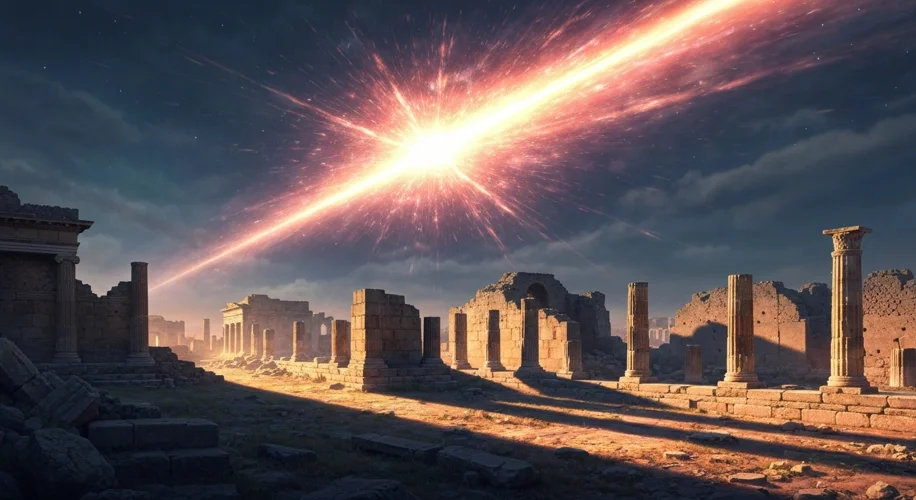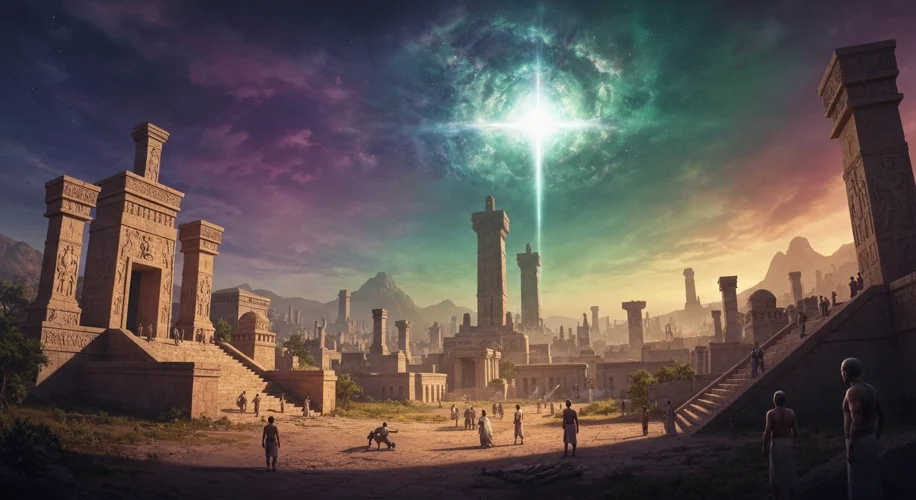The night sky, a canvas of silent, distant fires, has always captivated humanity. For millennia, we’ve gazed upwards, charting constellations, weaving myths, and pondering our place in the vast expanse. But what if, long before recorded history, one of those distant fires unleashed a fury that not only reshaped our world but potentially erased an entire civilization from existence?
In the annals of scientific speculation, few theories are as tantalizing and as chilling as the idea that a cataclysmic cosmic event – perhaps a gamma-ray burst or a nearby supernova – could have been the architect of humanity’s early struggles, or worse, the silent executioner of a forgotten, advanced society.
Imagine a world, not so different from our own, teeming with life and perhaps even nascent, advanced technologies. This is not the stuff of science fiction alone; it’s a hypothesis rooted in the scientific understanding of the universe’s raw power. Scientists have long posited that a powerful burst of high-energy radiation, like a gamma-ray burst (GRB) or the explosion of a massive star (supernova), could have a devastating impact on a planet’s atmosphere and biosphere.
Let’s rewind the clock. Consider the Late Bronze Age, a period of sophisticated civilizations across the Mediterranean and the Near East – the Mycenaeans in Greece, the Egyptians, the Hittites. Around 1200 BCE, many of these powerful cultures experienced a dramatic and widespread collapse. Cities were destroyed, trade routes disintegrated, and much of the region plunged into a so-called Dark Age. The reasons for this widespread societal breakdown have been debated for centuries, with theories ranging from climate change and internal revolts to invasions by the mysterious Sea Peoples.

Now, scientists propose a cosmic trigger for this very collapse. In 2019, a team of researchers, including Adrian Melott, a physicist at the University of Kansas, and Brian Thomas, a professor at Washburn University, published findings suggesting that a gamma-ray burst, originating from a star collapsing perhaps thousands of light-years away, could have struck Earth around 3,000 years ago. This event, they argue, could have stripped away a significant portion of Earth’s protective ozone layer. Without this vital shield, the planet would have been bombarded by intense ultraviolet (UV) radiation from the sun.
The consequences would have been catastrophic. Increased UV radiation can damage DNA, cause mutations, and lead to widespread crop failure, devastating ecosystems, and ultimately, societal collapse. Melott and Thomas theorize that the radiation could have triggered a significant increase in terrestrial radiation levels, potentially leading to increased cancer rates and genetic damage in surviving populations.
While the theory doesn’t explicitly point to a single, highly advanced civilization being wiped out, it opens the door to such possibilities. What if there was a civilization, perhaps even more advanced than the established Bronze Age powers, that was more vulnerable to such an environmental shock? Their complex infrastructure, reliance on agriculture, or perhaps even their unique biological makeup could have made them susceptible to a sudden atmospheric change.
Consider the implications. If such an event occurred, it would have left little direct archaeological evidence of its cosmic cause. The destruction would appear terrestrial – famines, wars, societal breakdown. Yet, the ultimate culprit would have been a celestial titan, an explosion so immense that its light, traveling for millennia, delivered annihilation.
This hypothesis isn’t without its critics or its challenges. Pinpointing the exact timing and magnitude of such an event requires intricate astronomical calculations and a careful correlation with paleoclimatic and archaeological data. Scientists look for evidence such as increased levels of radioactive isotopes like beryllium-10 in ice cores and tree rings, which can serve as markers for past cosmic radiation events. Some studies have indeed found evidence of increased isotopes around the time of the Bronze Age collapse, lending some credence to the theory.
But let’s push the speculative envelope further. What if this wasn’t just a destructive event but a selective one? Could a highly advanced, yet perhaps environmentally fragile, civilization have succumbed while more resilient, less technologically complex societies managed to endure, albeit in a weakened state? The idea of a ‘lost civilization’ is a persistent human fascination, and a cosmic event provides a dramatic, albeit unprovable, mechanism for their disappearance.
Ultimately, the theory of a cosmic cataclysm as the cause of widespread societal collapse, or the demise of a lost advanced civilization, remains a compelling, albeit unconfirmed, chapter in our ongoing quest to understand Earth’s past. It serves as a stark reminder that while human endeavors shape our destiny, we are also profoundly subject to the unfathomable powers of the cosmos. The silent fires in the night sky are not just beautiful; they are a testament to the universe’s capacity for both creation and utter destruction, a truth that may well be etched into the very foundations of our ancient history.

